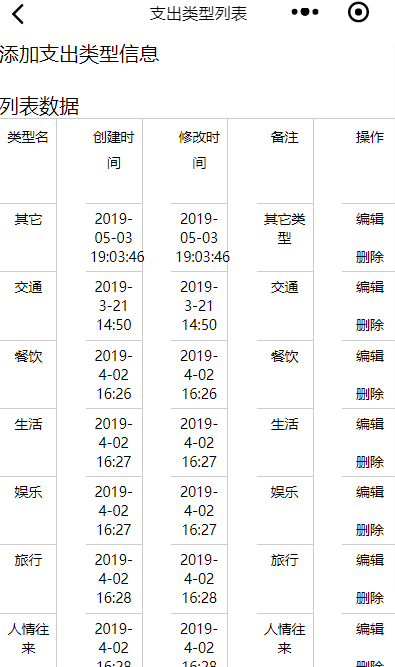溫馨提示×
您好,登錄后才能下訂單哦!
點擊 登錄注冊 即表示同意《億速云用戶服務條款》
您好,登錄后才能下訂單哦!
這篇文章將為大家詳細講解有關微信小程序中wx:for遍歷循環使用的示例分析,小編覺得挺實用的,因此分享給大家做個參考,希望大家閱讀完這篇文章后可以有所收獲。
效果圖如下:

實現代碼如下:
type.js:
// pages/type/type.js
Page({
/**
* 頁面的初始數據
*/
data: {
types: ""
},
editType: function (e) {
var typeId = e.currentTarget.dataset['id'];
console.log("edit:"+typeId);
wx.navigateTo({
url: '../type_edit/type_edit?typeId=' + typeId
})
},
delType:function(e){
var typeId = e.currentTarget.dataset['id'];
console.log("delete:"+typeId)
wx.showModal({
title: '提示',
content: '確認要刪除該支出類型?',
success: function (res) {
if (res.confirm) {
console.log('用戶點擊確定')
wx.request({
url: getApp().globalData.urlPath + "spendingType/delete",
method: "POST",
data: {
typeId: typeId
},
header: {
"Content-Type": "application/x-www-form-urlencoded"
},
success: function (res) {
console.log(res.data.code);
if (res.statusCode == 200) {
//訪問正常
if (res.data.code == "000000") {
wx.showToast({
title: "刪除成功,返回支出類型列表",
icon: 'success',
duration: 3000,
success: function () {
wx.navigateTo({
url: '../type/type'
})
}
})
}
} else {
wx.showLoading({
title: '系統異常',
fail
})
setTimeout(function () {
wx.hideLoading()
}, 2000)
}
}
})
} else if (res.cancel) {
console.log('用戶點擊取消')
}
}
})
},
/**
* 生命周期函數--監聽頁面加載
*/
onLoad: function (options) {
wx.setNavigationBarTitle({
title: "支出類型列表"
})
var userCode = wx.getStorageSync('userId');
var self = this
wx.request({
url: getApp().globalData.urlPath + "spendingType/types",//json數據地址
data: {
userCode: userCode
},
headers: {
"Content-Type": "application/x-www-form-urlencoded"
},
success: function (res) {
self.setData({
types: res.data.data
});//等同于
}
})
},
/**
* 生命周期函數--監聽頁面初次渲染完成
*/
onReady: function () {
},
/**
* 生命周期函數--監聽頁面顯示
*/
onShow: function () {
},
/**
* 生命周期函數--監聽頁面隱藏
*/
onHide: function () {
},
/**
* 生命周期函數--監聽頁面卸載
*/
onUnload: function () {
},
/**
* 頁面相關事件處理函數--監聽用戶下拉動作
*/
onPullDownRefresh: function () {
},
/**
* 頁面上拉觸底事件的處理函數
*/
onReachBottom: function () {
},
/**
* 用戶點擊右上角分享
*/
onShareAppMessage: function () {
}
})type.js沒什么好說的,如果要說,只能說這個onLoad這里的onLoad就相當于js中的onload方法,當進入該視圖時,默認全局加載一次。
type.wxml:
<view>
<view>
<navigator url="/pages/type_add/type_add" hover-class="navigator-hover">添加支出類型信息</navigator>
</view>
<view>
<text>\n</text>
</view>
<view>
<view>
<text>列表數據</text>
<text>\n</text>
</view>
<view class="table">
<view class="tr thead">
<view class="td">類型名</view>
<view class="td">創建時間</view>
<view class="td ">修改時間</view>
<view class="td">備注</view>
<view class="td ">操作</view>
</view>
<block>
<view class="tr" wx:for="{{types}}" wx:for-item="item">
<view class="td">{{item.typeName}}</view>
<view class="td">{{item.createDate}}</view>
<view class="td">{{item.modifyDate}}</view>
<view class="td">{{item.remark}}</view>
<view class="td">
<text bindtap='editType' data-id="{{item.typeId}}">編輯</text>
<text>\n</text>
<text>\n</text>
<text bindtap='delType' data-id="{{item.typeId}}">刪除</text>
</view>
</view>
</block>
</view>
</view>
</view>遍歷循環主要使用的是wx:for。如果要類比的話,我覺得jstl跟這個神似。先來看看jstl,代碼如下:
<c:forEach var="u" items="${user}">
<tr>
<td>${u.cid}</td>
<td>${u.cname}</td>
<td>${u.age }</td>
</tr>
</c:forEach>var相當于我可以任意定義一個簡要字母來調用item(item相當于type.js中的data或self.setData存儲的數據)。
如果你還不明白的話,可以聯系到$.each,代碼如下:
$.each(classroom_list, function(i, c) {
rows = rows + "<tr>";
rows = rows + "<td>" + c.id + "</td>";
rows = rows + "<td>" + c.nickname + "</td>";
rows = rows + "<td><a href='student_submit_info.html?userId="+c.id+"'>查看詳情</a></td>";
rows = rows + "</tr>"
});type.wxss:
.table {
border: 1px solid #ccc;
font-size: 28rpx;
background: #fff;
border-right: none;
}
.tr{
display: flex;
justify-content: space-between;
}
.td {
text-align: center;
border: 1px solid #ccc;
display: inline-block;
border-left: none;
border-bottom: none;
padding: 10rpx 1%;
width: 12%;
}
.thead .td{
border-top: none;
height: 140rpx;
line-height: 50rpx;
}關于“微信小程序中wx:for遍歷循環使用的示例分析”這篇文章就分享到這里了,希望以上內容可以對大家有一定的幫助,使各位可以學到更多知識,如果覺得文章不錯,請把它分享出去讓更多的人看到。
免責聲明:本站發布的內容(圖片、視頻和文字)以原創、轉載和分享為主,文章觀點不代表本網站立場,如果涉及侵權請聯系站長郵箱:is@yisu.com進行舉報,并提供相關證據,一經查實,將立刻刪除涉嫌侵權內容。